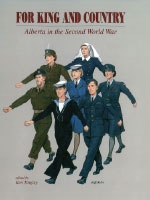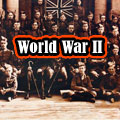Morale and Morality on the Alberta Homefront
Jeff Keshen
Reprinted with permission of the author and publisher of For King and Country: Alberta in the Second World War With minimal help from the provincial government, a number of school districts, primarily but not exclusively in underpopulated rural areas, found themselves starved for money. This fact was reflected in the salary of teachers; their average pay in Alberta in 1940 stood at $860 per annum, roughly equivalent to the national mean in that occupation, but about $500 less than an industrial worker. As late as 1944 some instructors in one-room country schoolhouses brought home, after taxes, $58 monthly.58 Of course, the war created other employment opportunities of which numerous teachers promptly took advantage. By the end of 1943, the year in which Ottawa finally froze teachers in their jobs except for military service, the exodus of instructors was blamed for the closure of 449 Alberta schools, most of which were located in rural districts and forced children to bus long distances.59
With minimal help from the provincial government, a number of school districts, primarily but not exclusively in underpopulated rural areas, found themselves starved for money. This fact was reflected in the salary of teachers; their average pay in Alberta in 1940 stood at $860 per annum, roughly equivalent to the national mean in that occupation, but about $500 less than an industrial worker. As late as 1944 some instructors in one-room country schoolhouses brought home, after taxes, $58 monthly.58 Of course, the war created other employment opportunities of which numerous teachers promptly took advantage. By the end of 1943, the year in which Ottawa finally froze teachers in their jobs except for military service, the exodus of instructors was blamed for the closure of 449 Alberta schools, most of which were located in rural districts and forced children to bus long distances.59
Fewer teachers, as well as a general rural-to-urban migration, accounted for a greater number of congested classrooms. In September 1942, 120 of 204 Calgary classrooms assigned to grades one through six had 35 or more children, despite a school board policy limiting the number to thirty.60 Concern also grew over the quality of instruction as school boards found themselves under tremendous pressure to quickly hire replacements. While many married women called back into service were of high calibre, some retirees were not physically up to the task, while at the other end of the age scale was an increasing number who were placed in classrooms before having completed their required course of study.
Yet the wartime teacher shortage, when combined with the rise in truancy and delinquency, also focused more attention on schooling and the need for improvements. "A surge of interest" is how the A. T.A. Magazine characterized the trend in 1944 after surveying several magazines and newspapers over the past year.61 By 1945, in order to keep people in the profession and re-attract former teachers returning from the war, the Alberta government, following the lead of Ontario and Saskatchewan, promised a minimum salary of $1,000. The provincial government and AT A followed the national trend by making greater efforts to encourage professionalization. This process was seen as serving both groups by creating a system not only more academically effective, but whose teachers would have a stronger case for better pay, and consequently more loyalty to the job. In this spirit, the Alberta government in 1944 underwrote costs for a record number of summer upgrading courses for teachers, and centralized training for high school level instruction at the provincial university.62
Helping to make such initiatives possible were changes in both the quantity and source of education funding. Although the AT A was disappointed that Ottawa, as part of its wartime expansion into social welfare, balked at taking a constitutional foray into this area to raise and equalize educational services across the country, still it saw reason to express optimism over the school of the future. Between 1939 and 1946 Alberta reflected a general trend when it increased its total educational expenditures from $10.2 million to $14.9 million, with the provincial contribution rising from approximately 18 to 30 per cent.63 Moreover, greater centralized direction sped the move to enlarge school districts, which had proceeded rather slowly before the war. One-room schoolhouses, most provincial officials seemed to agree, were not cost-effective, offered inadequate services, often injected unproductive local idiosyncrasies into the curriculum, and, according to a 1944 ATA study which endorsed centralization, produced students who scored about ten per cent lower on standardized mathematics, social studies, language and science tests.64
In larger rural institutions, as well as a number of urban schools to which additions were planned, not only were superior facilities promised in areas such as science, but also decent gymnasiums, industrial arts courses formerly often available only at technical schools, as well as music and art classes. Educational strategy also called for the expansion of vocational guidance services which it was hoped would link high school students with a course of training to which they were both suited and where jobs existed. A rudimentary version of this service was inaugurated in Calgary's Western High School in 1934, although it was not until the 1941-42 academic year that the programme began to expand. By the end of the war both Calgary and Edmonton had guidance directors for their school systems.65 The idea was to make the modern educational facility a more dynamic and relevant place, especially for adolescent students. Those undecided about whether to take a vocational or academic course of studies could experiment with both in these new and larger institutions; it was predicted that this new postwar system would produce fewer truants as well as a better trained and more content work force.
Notes
58. Historical Statistics of Canada 2nd edition, Series E41-48; A.T.A Magazine, Feb 1944, 12-3.
59. Ibid, Jan 1944, 8.
60. GL, MG 5841, 1943 Yearbook, 31.
61. A.T.A. Magazine, Jan. 1945, 9.
62. Ibid, May 1944, 33-4, Jan. 1945, 15.
63. Canada Yearbook, 1948-49, 316-7.
64. A.T.A. Magazine, Jan. 1945, 6.
65. John Abram Ross Wilson, The Counsellor in Canadian Secondary Schools, Education Doctorate, Oregon State College, 1951, 22-3.








